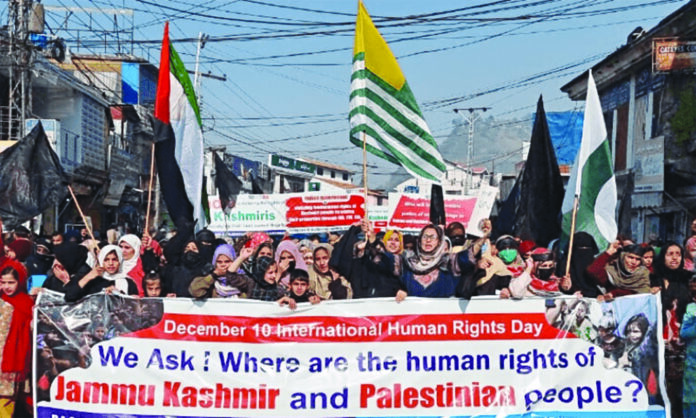-Agha Shahid Ali, The Country Without a Post Office.
Kashmir, often referred to as Paradise on Earth, has a tumultuous history marked by a prolonged dispute between India and Pakistan, stemming from the partition of 1947. Despite being hailed for its breathtaking beauty, Kashmir has been a battleground for political and territorial claims, leaving its resilient inhabitants caught in the crossfire. In today’s global landscape, where ideals of equality and justice are championed, it’s disheartening to witness regions like Kashmir and Palestine suffer from systematic deprivation of fundamental rights.
Despite the rhetoric of fairness and equality, the people of Kashmir and Palestine find themselves deprived of access to a just legal system, with their voices silenced and their grievances unheard. Families in Kashmir and Palestine live under constant threat, with their loved ones facing danger from targeted military operations. Despite decades of struggle, the rights of Kashmiris remain unfulfilled, echoing the unresolved conflicts seen in places like Palestine. While the United Nations Security Council has passed numerous resolutions addressing the Kashmir conflict, a peaceful resolution remains elusive. The plight of Kashmir serves as a poignant reminder of the ongoing struggle for justice and peace in our world.
The problems in both Kashmir and Palestine date back to 1947. Israel maintains its illegal occupation of Palestinian territories, while on the other side, Kashmir is still an unresolved and disputed issue between India and Pakistan. The whole world is aware that the situation in Palestine is worsening day by day. The October 7 attack by Hamas exposed vulnerabilities in Israel’s defense, prompting efforts to restore its military dominance. The Israeli Defense Forces have been responsible for the deaths of approximately 30,000 Palestinians, a significant portion of whom are children, and have caused extensive destruction in Gaza. The ongoing conflict has resulted in a daily toll of around 250 Palestinian lives, with many more facing threats from hunger, disease, and harsh conditions. In addition to the casualties inflicted by Hamas, attacks by armed groups in Israel on the same day led to the deaths of over 1,200 people.
Furthermore, 330 Palestinians have been killed in the West Bank since then. As of the latest estimates by UNRWA, about 75 percent of Gaza’s population, including more than half of its children, have been displaced. Residents of Gaza describe life as a grim choice between facing death or being forced to leave their homes. The future of the besieged enclave remains uncertain, with ongoing debates about what lies ahead. It is unclear whether the estimated 1.9 million Palestinians who fled to the southern parts of Gaza will ever be able to return and find their homes intact or if they now lie in ruins.
Continued political instability could lead to further conflict between Gaza and Israel, exacerbating the already dire circumstances for the people of Gaza. Additionally, developments in neighbouring countries and their relations with Gaza and Israel may influence the situation. Changes in these relationships could either improve or worsen conditions for Gaza in the future.
Both Palestine and Kashmir have suffered under occupation, global political manoeuvring, humanitarian crises, and the neglect of human rights by supposed advocates. While the origins of the ongoing conflicts in Palestine and Indian-administered Kashmir differ, how people in both regions are fighting for freedom highlights a shared similarity between these globally recognized disputed areas. Kashmir has witnessed a cycle of spontaneous pro-Palestine protests and shutdowns during the past couple of years.
Talking about the current situation, India claims that four years after the Centre abrogated the special status of Jammu and Kashmir under Article 370 on 5 August 2019, the restoration of peace and developmental activities taking place, compared to the past, stand out as its most significant achievements. It is after more than three decades that public and social life in the erstwhile state, in general, and the valley in particular, are back to normal routine without disruption. While 124 civilians were killed at the hands of police and security forces during protests and there were stone-pelting incidents from 5 August 2016 to 5 August 2019, not a single such incident was reported in the last four years, official figures reveal. But let’s see what is happening in Kashmir. Is this claim right that Kashmir is going towards development, or could it be said that the situation in Kashmir is drifting towards the situation in Palestine?
Article 370, which granted special autonomous status to Jammu and Kashmir, was seen by many Kashmiris as a symbol of their distinct identity and political rights. The abrogation of this article effectively centralized power in the Indian government, leading to a sense of disenfranchisement and marginalization among Kashmiris, who felt their political voice and autonomy were being undermined. The revocation of Article 370 also had economic repercussions. It led to uncertainty and disruption in various sectors, including tourism, trade, and real estate, which are crucial for the economy of Kashmir. The region experienced restrictions on movement, communication blackouts, and a decline in business activities, affecting livelihoods and economic stability. The question of whether Article 370 signifies India’s colonization of Kashmir depends on how one views the situation. While Kashmir has been viewed through a colonial lens before, the revocation of Article 370 suggests that a settler-colonial perspective might be more appropriate. Settler colonialism involves the recruitment of a settler class whose aim is not only to occupy indigenous land but also to eradicate the indigenous people who resist them. Consequently, as non-Kashmiris migrate to the region as new residents, India’s identity as a settler state becomes increasingly evident.
In the face of such adversity, we must amplify the voices of the marginalized and oppressed, shining a light on their struggles and advocating for their rights. Only through collective action and solidarity can we hope to bring about meaningful change and pave the way towards a future where justice and equality prevail for all.
The suffering of Palestinians and Kashmiris is undeniable, yet there’s a heated debate about the world’s ostrich-like policy, which has turned a blind eye to these enduring atrocities for decades. The recent failure of the UN to enforce a ceasefire in Gaza vividly illustrates how power dynamics and military dominance continually overshadow the principles of a fair and just order. It’s no understatement to say that the UN, both as an idea and in practice, is deeply flawed, especially when it comes to maintaining peace. The images and reports from Gaza depict the tragic plight of the Palestinian people, raising poignant questions about the whereabouts of Muslim rulers and those who profess to be advocates of conscience. The barbarity and mercilessness endured by Gaza’s inhabitants demand urgent intervention and support from Arab Muslim leaders.
As Martin Luther King once said, “In the end, we will remember not the words of our enemies but the silence of our friends.” It’s crucial to acknowledge the role of Western leaders in exacerbating the situation in Gaza and to question their commitment to human rights, especially considering the massacres perpetrated by the occupying forces, which claim the lives of innocent children, women, and elderly individuals.
The deafening silence of world leaders echoes through the plight of our Muslim brethren in Palestine and Kashmir, where lives hang in the balance. While the Palestinian issue has garnered widespread attention and advocacy from various quarters, the suffering of Kashmiris remains largely unnoticed, shrouded in the shadows of neglect and indifference. Indian authorities paint a rosy picture of Kashmir’s transformation, boasting of eradicating terrorism and restoring peace.
The rich culture of the Valley has been buried by the forceful practices of the occupiers. Yet, beneath this facade lies a harrowing reality, one where Kashmiris find their voices stifled, their dissent crushed, and their aspirations ignored. Their narratives have been forcefully moulded to fit the narrative of the authorities, coerced into echoing sentiments that betray their truths. Amidst the facade of development, Kashmir is depicted as a serene paradise, a tourist’s dream destination. But behind the veneer of tranquillity lies a truth steeped in suffering and oppression.
While there has indeed been progress in Kashmir, it has largely been at the expense of its indigenous inhabitants, who find themselves marginalized and disenfranchised in their land. Unemployment plagues the youth of Kashmir, especially those with higher education, who find themselves trapped in a cycle of despair with limited job prospects and meagre salaries. The government’s policies favour outsiders, as land is seized from innocent civilians to accommodate settlers, echoing the dark shadows of colonialism and dispossession.
The Kashmiri people, caught in the crossfire of political agendas and power struggles, face an uncertain future. Their hopes and dreams are overshadowed by the looming spectre of uncertainty and oppression. If the international community continues to turn a blind eye to their plight, Kashmir may tragically become another casualty in the ongoing struggle for justice and human rights.
In the face of such adversity, we must amplify the voices of the marginalized and oppressed, shining a light on their struggles and advocating for their rights. Only through collective action and solidarity can we hope to bring about meaningful change and pave the way towards a future where justice and equality prevail for all.























